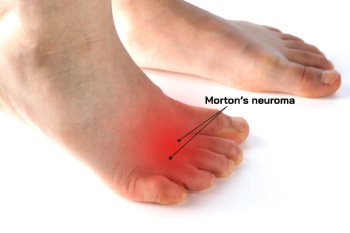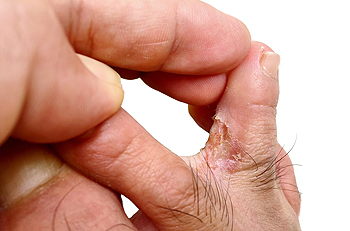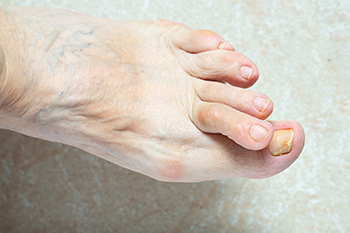Connect With Us
Blog
Items filtered by date: March 2025
Exercises Can Ease Morton’s Neuroma Pain

Morton’s neuroma affects the ball of the foot, often occurring between the third and fourth toes. Morton’s neuroma develops when the plantar digital nerve becomes compressed. This leads to thickened tissue and causes sharp or burning pain, numbness, or the sensation of a pebble inside the shoe. Exercises can help by improving foot strength, flexibility, and alignment to reduce pressure on the nerve. Toe-spreading exercises encourage natural toe positioning, while stretching the big toe and calf muscles can relieve tension in the forefoot. Strengthening exercises, such as towel curls and single-leg balance drills, help stabilize the foot and distribute weight more evenly during movement. Rolling a ball under the arch of the foot may also aid in reducing discomfort. While these exercises may provide relief, persistent symptoms should not be ignored. A podiatrist can evaluate your symptoms, recommend orthotic support if necessary, and determine whether additional treatment is required. If you have symptoms of Morton's neuroma, it is suggested that you schedule an appointment with a podiatrist for an exam, diagnosis, and treatment options.
Morton’s neuroma is a very uncomfortable condition to live with. If you think you have Morton’s neuroma, contact Tanisha Richmond, DPM of Richmond Foot & Ankle, LLC. Our doctor will attend to all of your foot care needs and answer any of your related questions.
Morton’s Neuroma
Morton's neuroma is a painful foot condition that commonly affects the areas between the second and third or third and fourth toe, although other areas of the foot are also susceptible. Morton’s neuroma is caused by an inflamed nerve in the foot that is being squeezed and aggravated by surrounding bones.
What Increases the Chances of Having Morton’s Neuroma?
- Ill-fitting high heels or shoes that add pressure to the toe or foot
- Jogging, running or any sport that involves constant impact to the foot
- Flat feet, bunions, and any other foot deformities
Morton’s neuroma is a very treatable condition. Orthotics and shoe inserts can often be used to alleviate the pain on the forefront of the feet. In more severe cases, corticosteroids can also be prescribed. In order to figure out the best treatment for your neuroma, it’s recommended to seek the care of a podiatrist who can diagnose your condition and provide different treatment options.
If you have any questions, please feel free to contact our office located in Dayton, OH . We offer the newest diagnostic and treatment technologies for all your foot care needs.
Reminder: When Was the Last Time...?
Custom Orthotics For Seniors

Age gracefully and move freely with Custom Orthotics. For seniors seeking to maintain their independence, Custom Orthotics offer the stability and comfort essential for daily activities. Custom-tailored to your feet, they provide support, reduce pain, and enhance mobility, ensuring you're always on sure footing. Don't let age-related foot concerns hold you back. With Custom Orthotics, embrace every golden moment with confidence. Call today to schedule an appointment.
An Itch Not to Ignore

It starts as a mild itch, just a little irritation between your toes. Maybe your skin feels dry or slightly cracked. Then, before you know it, that subtle annoyance turns into relentless burning, peeling, and redness. Athlete’s foot is not just a minor inconvenience. It is a fungal invasion thriving in warm, damp spaces like sweaty socks and shared locker rooms. Many people dismiss it, thinking it is just dry skin, but, left untreated, it spreads. Blisters can form, skin can crack open, and secondary infections can take hold. Some even find the fungus creeping into their toenails, making them thick and discolored. Scratching only makes it worse, spreading the infection to hands and other areas. Mild treatments may help, but if it keeps coming back or worsens, it is suggested that you schedule an appointment with a podiatrist who can provide stronger solutions to stop the cycle and restore healthy skin.
Athlete’s foot is an inconvenient condition that can be easily reduced with the proper treatment. If you have any concerns about your feet and ankles, contact Tanisha Richmond, DPM from Richmond Foot & Ankle, LLC. Our doctor will treat your foot and ankle needs.
Athlete’s Foot: The Sole Story
Athlete's foot, also known as tinea pedis, can be an extremely contagious foot infection. It is commonly contracted in public changing areas and bathrooms, dormitory style living quarters, around locker rooms and public swimming pools, or anywhere your feet often come into contact with other people.
Solutions to Combat Athlete’s Foot
- Hydrate your feet by using lotion
- Exfoliate
- Buff off nails
- Use of anti-fungal products
- Examine your feet and visit your doctor if any suspicious blisters or cuts develop
Athlete’s foot can cause many irritating symptoms such as dry and flaking skin, itching, and redness. Some more severe symptoms can include bleeding and cracked skin, intense itching and burning, and even pain when walking. In the worst cases, Athlete’s foot can cause blistering as well. Speak to your podiatrist for a better understanding of the different causes of Athlete’s foot, as well as help in determining which treatment options are best for you.
If you have any questions please feel free to contact our office located in Dayton, OH . We offer the newest diagnostic and treatment technologies for all your foot and ankle needs.
Insoles for Symptomatic Flexible Flatfoot in Children

Children with symptomatic flexible flatfoot often experience discomfort, pain, and fatigue due to the collapse of the arch. Customized arch support insoles can provide significant relief by offering targeted support and helping to restore proper foot alignment. These insoles are specifically designed to address the unique needs of a child's developing feet, promoting healthier movement patterns and reducing excessive stress on joints and tissues. By improving arch support, customized insoles help to distribute weight more evenly across the foot, minimizing discomfort and preventing further complications. They also aid in correcting abnormal foot mechanics, reducing the risk of pain or deformities in the future. For children with flexible flatfoot, customized arch support insoles can provide a practical, non-invasive solution that supports their foot health and promotes active, pain-free movement. If your child has flat feet, it is suggested that you consult a podiatrist who can determine which type of orthotics your child will benefit from wearing.
If you are experiencing discomfort in your feet and would like to try custom orthotics, contact Tanisha Richmond, DPM from Richmond Foot & Ankle, LLC. Our doctor can provide the care you need to keep you pain-free and on your feet.
What Are Custom Orthotics?
Custom orthotics are inserts you can place into your shoes to help with a variety of foot problems such as flat feet or foot pain. Orthotics provide relief and comfort for minor foot and heel pain.
Over-the-Counter Inserts
Shoe inserts come in a wide variety and are used to treat foot pain, heel pain, and minor problems. For example, arch supports can be inserted into your shoes to help correct overarched or flat feet, while gel insoles are often used because they provide comfort and relief from foot and heel pain by alleviating pressure.
Prescription Orthotics
If over-the-counter inserts don’t work for you or if you have a more severe foot concern, it is possible to have your podiatrist prescribe custom orthotics. These high-quality, custom inserts are designed to treat problems such as abnormal motion, plantar fasciitis, and severe forms of heel pain. They can even be used to help patients suffering from diabetes by treating foot ulcers and painful calluses and are usually molded to your feet individually, which allows them to provide full support and comfort.
If you're experiencing minor to severe foot or heel pain, it’s recommended to speak with your podiatrist about the possibility of using custom orthotics or shoe inserts. A podiatrist can determine which type of custom orthotic or shoe insert is right for you and help you take the first steps toward being pain-free.
If you have any questions please contact our office located in Dayton, OH . We offer the newest diagnostic and treatment technologies for all your foot and ankle needs.
When Hammertoe Surgery May Not Be Effective

Hammertoe surgery is designed to correct toe deformities, but certain risk factors can make the procedure less successful. Poor circulation, often seen in people with diabetes or peripheral artery disease, slows healing and increases the risk of complications. Individuals with severe arthritis may struggle with joint stiffness even after surgery, limiting mobility and causing lingering discomfort. Weak bones due to osteoporosis can also make surgical correction less stable, increasing the chances of recurrence. Chronic swelling from conditions like lymphedema may lead to prolonged recovery and difficulties wearing shoes comfortably. Smoking and obesity further hinder healing by reducing oxygen supply and placing excess pressure on the feet. Non-surgical options such as orthotics, toe splints, and targeted exercises may be better alternatives for those at high risk. If you are in a high-risk group and would like relief for your hammertoe, it is suggested that you consult a podiatrist who can help determine the safest and most effective treatment based on your specific health concerns.
Hammertoes can be a painful condition to live with. For more information, contact Tanisha Richmond, DPM of Richmond Foot & Ankle, LLC. Our doctor will answer any of your foot- and ankle-related questions.
Hammertoe
Hammertoe is a foot deformity that occurs due to an imbalance in the muscles, tendons, or ligaments that normally hold the toe straight. It can be caused by the type of shoes you wear, your foot structure, trauma, and certain disease processes.
Symptoms
- Painful and/or difficult toe movement
- Swelling
- Joint stiffness
- Calluses/Corns
- Physical deformity
Risk Factors
- Age – The risk of hammertoe increases with age
- Sex – Women are more likely to have hammertoe compared to men
- Toe Length – You are more likely to develop hammertoe if your second toe is longer than your big toe
- Certain Diseases – Arthritis and diabetes may make you more likely to develop hammertoe
Treatment
If you have hammertoe, you should change into a more comfortable shoe that provides enough room for your toes. Exercises such as picking up marbles may strengthen and stretch your toe muscles. Nevertheless, it is important to seek assistance from a podiatrist in order to determine the severity of your hammertoe and see which treatment option will work best for you.
If you have any questions, please feel free to contact our office located in Dayton, OH . We offer the newest diagnostic and treatment technologies for all your foot care needs.
Why Live with Pain and Numbness in Your Feet?
Symptoms and Treatment of Stress Fractures

Stress fractures in the feet, toes, and ankles occur when repeated pounding causes bone tissue to weaken faster than it can rebuild. Unlike a typical fracture, a stress fracture is a small crack or severe weakness in the bone, rather than a complete break. Commonly seen in athletes who run or jump frequently, stress fractures often result from abrupt increases in training, changes in surfaces, or returning to activity too quickly after a break. Symptoms include localized pain that worsens with weight-bearing, tenderness, and occasional swelling. Early in the injury, discomfort may occur only during activity but can progress to persistent pain with daily movements. Women, people with low bone density, and those with poor muscle strength or inadequate nutrition may face a higher risk. A podiatrist can diagnose stress fractures through imaging tests and address underlying causes, like improper footwear or training habits. Treatment usually includes immobilization to allow healing and guidance on safe activity resumption. If you believe you may have developed stress fractures in your feet, it is suggested that you schedule an appointment with a podiatrist for an exam and treatment.
Activities where too much pressure is put on the feet can cause stress fractures. To learn more, contact Tanisha Richmond, DPM from Richmond Foot & Ankle, LLC. Our doctor can provide the care you need to keep your pain free and on your feet.
Dealing with Stress Fractures of the Foot and Ankle
Stress fractures occur in the foot and ankle when muscles in these areas weaken from too much or too little use. The feet and ankles then lose support when walking or running from the impact of the ground. Since there is no protection, the bones receive the full impact of each step. Stress on the feet can cause cracks to form in the bones, thus creating stress fractures.
What Are Stress Fractures?
Stress fractures occur frequently in individuals whose daily activities cause great impact on the feet and ankles. Stress factors are most common among:
- Runners
- People affected with Osteoporosis
- Tennis or basketball players
- Gymnasts
- High impact workouts
Symptoms
Pain from the fractures occur in the area of the fractures and can be constant or intermittent. It will often cause sharp or dull pain with swelling and tenderness. Engaging in any kind of activity which involves high impact will aggravate pain.
If you have any questions please feel free to contact our office located in Dayton, OH . We offer the newest diagnostic and treatment technologies for all your foot and ankle needs.
Blog Archives
- April 2025
- March 2025
- February 2025
- January 2025
- December 2024
- November 2024
- October 2024
- September 2024
- August 2024
- July 2024
- June 2024
- May 2024
- April 2024
- March 2024
- February 2024
- January 2024
- December 2023
- November 2023
- October 2023
- September 2023
- August 2023
- July 2023
- June 2023
- May 2023
- April 2023
- March 2023
- February 2023
- January 2023
- December 2022
- November 2022
- October 2022
- September 2022
- August 2022
- July 2022
- June 2022
- May 2022
- April 2022
- March 2022
- February 2022
- January 2022
- December 2021
- November 2021
- October 2021
- September 2021
- August 2021
- July 2021
- June 2021
- May 2021
- April 2021
- March 2021
- February 2021
- January 2021
- December 2020
- November 2020
- October 2020
- September 2020
- August 2020
- July 2020
- June 2020
- May 2020
- April 2020
- March 2020
- February 2020
- January 2020
- December 2019
- November 2019
- October 2019
- September 2019
- August 2019
- July 2019
- June 2019
- May 2019
- April 2019
- March 2019
- February 2019
- January 2019
- December 2018
- November 2018

